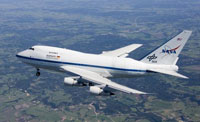NASA builds flying telescope to explore stars and black holes
NASA has built its first flying observatory on the base of Boeing 747 airplane that used to fly passengers across the Pacific Ocean. The new observatory, named SOFIA, now carries a 17-ton telescope that will soon start to explore the Universe searching for new stars in the Orion nebula. The telescope will also probe a black hole in the middle of the Milky Way galaxy.

The whole aft cabin of the plane is filled with the primary mirror of the huge telescope. The mirror, open to the sky, is 100 inches in diameter. It is larger than the mirror of the Hubble Space Telescope that orbits the Earth.
The name of NASA’s new observatory is an acronym for Stratospheric Observatory for Infrared Astronomy. "It will give us better clarity than we could ever imagine, and enable us to see things we couldn't even think about seeing,” SOFIA’s chief scientist, Eric Becklin said.
The flying telescope will observe stars as they glow in the infrared region of the spectrum. Infrared can reach molecules of water vapor eight miles in the sky. It also pierces clouds of dust in interstellar space.
NASA bought the Boeing 747 from United Airlines. The telescope was built by the German Space Agency. The flights will now be open to astronomers all over the world. The first flight will take place later this year.
The Hubble Space Telescope (HST) is a telescope in orbit around the Earth, named after astronomer Edwin Hubble. Its position outside the Earth's atmosphere provides significant advantages over ground-based telescopes - images are not blurred by the atmosphere, there is no background from light scattered by the air, and the Hubble can observe ultra-violet light that is normally absorbed by the ozone layer in observations made from Earth. Though not the first space telescope, since its launch in 1990, it has become one of the most important instruments in the history of astronomy. With it, astronomers have made many observations leading to breakthroughs in astrophysics. Hubble's Ultra Deep Field has the most detailed visible light image of the most distant objects ever taken.
Photo by: New Scientist
Subscribe to Pravda.Ru Telegram channel, Facebook, RSS!


